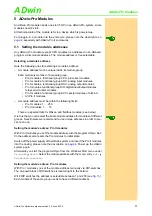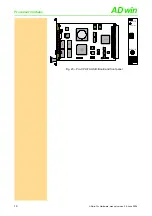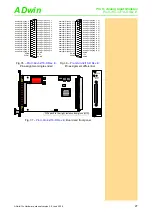
ADwin-Pro
Hardware, manual version 2.9, June 2006
19
Processor modules
ADwin
READ_TIMER
– The time unit of 3.3 ns is also true for the internal counter, i.e. counter
queries with
READ_TIMER
must be adapted, too.
Please note: The process timing in connection with I/O instructions has
become more complex (see below). Thus, a time difference determined
with
READ_TIMER
will now refer to a part of the total process timing only.
SLEEP
– The instruction
SLEEP
must be replaced by one of the following new
instructions.
•
CPU_SLEEP
causes the processor to wait. The instruction
SLEEP
had the same function with the processors T9 and T10.
•
P1_SLEEP
causes the Pro I bus to wait, e.g. to co-ordinate I/O
instructions.
•
P2_SLEEP
causes the Pro II bus to wait, e.g. to co-ordinate I/O
instructions.
The new instructions have a time unit of 10ns (
SLEEP
: 100ns).
Which instruction is right? Normally
SLEEP
is used to bridge the waiting
time of an I/O instruction, e.g. the settling time of a multiplexer with
SET_MUX
. In this case the instruction
P1_SLEEP
fits for previous mod-
ules (Pro I bus), and
P2_SLEEP
for Pro II modules.
Please see the notes in the
ADbasic
manual about
Why are there new instructions? The processor T11 distinguishes pro-
cessor instructions on theone hand and I/O instructions on the other
hand. The processor architecture enables a quasi-parallel processing
1
of both instruction groups and obtains a much faster processing of
AD-
basic
processes. This also means that the instruction groups are (main-
ly) processed independently in respect to timing. Since the process
timing shall be controlled by waiting, there needs to be a separate in-
struction for each group. The separate instruction for each bus is re-
quired, because an I/O wait is effected by halting the appropriate bus.
1. The processor architecture differs from T9 and T10 in this point: T9 and T10 processed instruc-
tions of both groups sequentially. Thus, halting the processor with a
SLEEP
instruction did
make the waiting time for subsequent I/O instructions, too.
















































